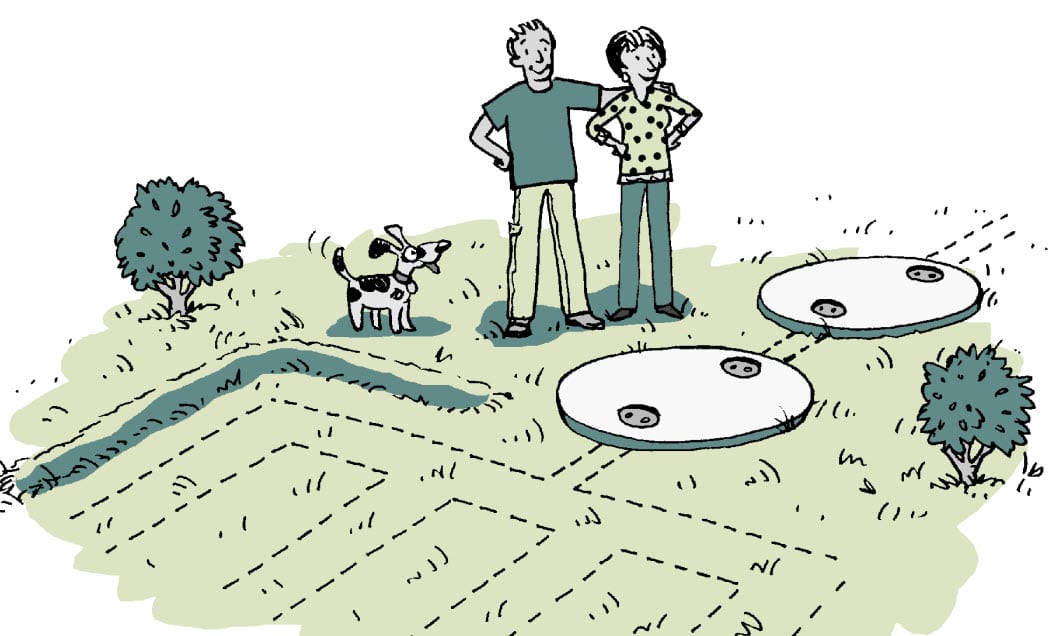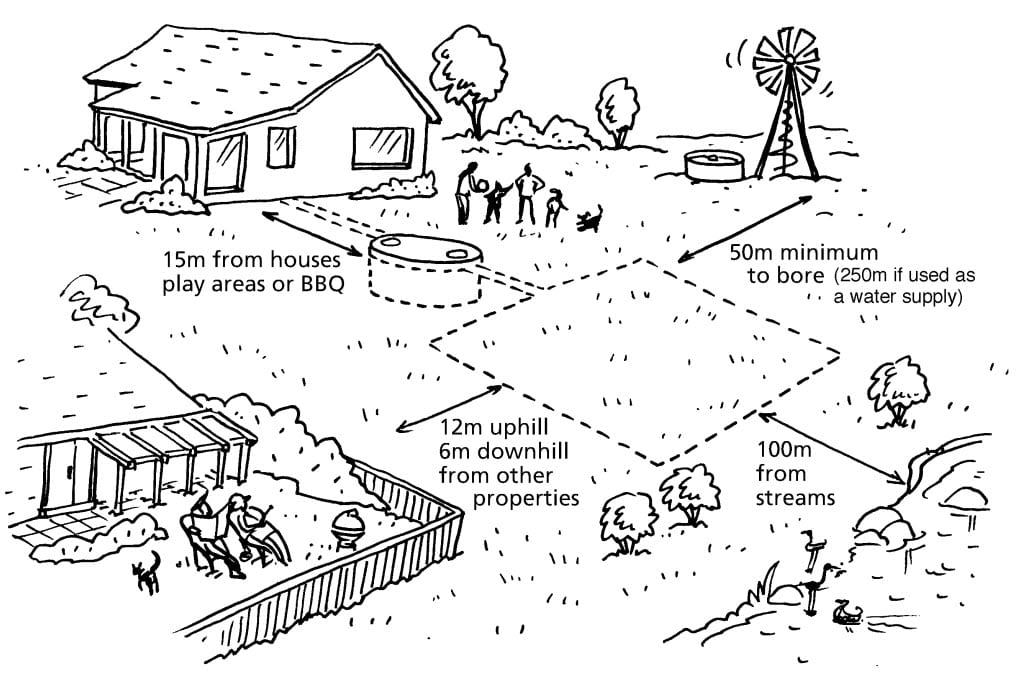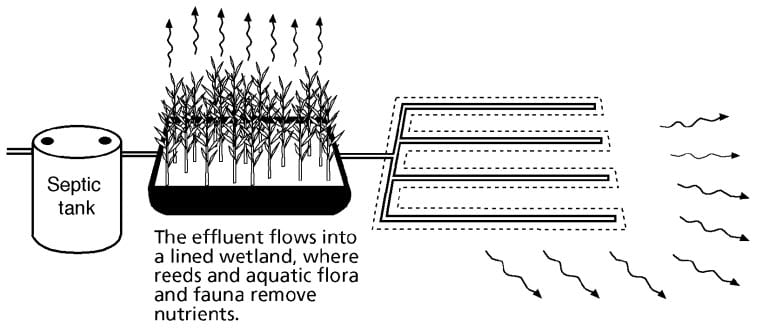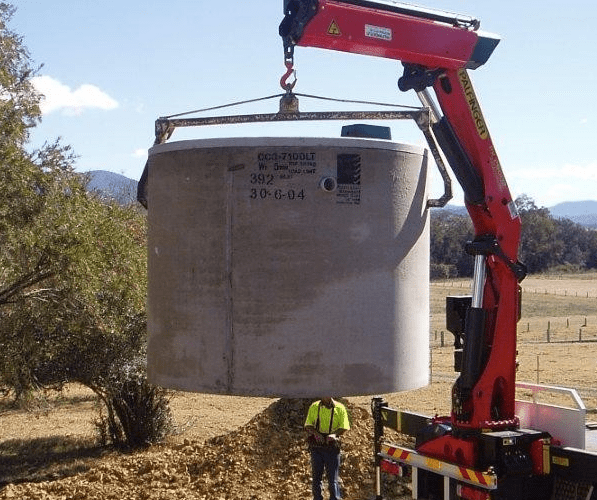What do I need to know before buying a septic system?
Before buying a septic tank, your first step should be to obtain some advice and investigate what option will best suit your land before you invest. Do your homework before investing!
If you’re buying land for a new home, check into local wastewater regulations to explore your septic system options and obligations before you buy. Your local council or local land-use consultant should be able to advise you. Many councils use a three-class risk classification scheme for wastewater (high, medium, and low risk). Council should inform you what area you fall into, what kind of septic systems are allowed, and whether you must have septic tank filters or septic tank drain fields.
When planning your septic system, you will want to factor in how close your tank and irrigation area are to your neighbouring properties.
You will want your septic tank system to be:
- 15m away from the house, outdoor play areas and BBQ
- 50m minimum away from water bore (250m away if used as a water supply)
- 12m uphill or 6m downhill from other properties
- 100m from streams
Groundwater is easily contaminated. Ensure your septic system is located at a safe distance from wells, bores, creeks, lakes and houses.
Note: Water polluters in NSW can face hefty clean-up notices and fines. Penalties can be up to $120,000 for individuals and $250,000 for corporations for pollution offences under New South Wales law.
What types of Septic Tanks and Septic Systems are available?
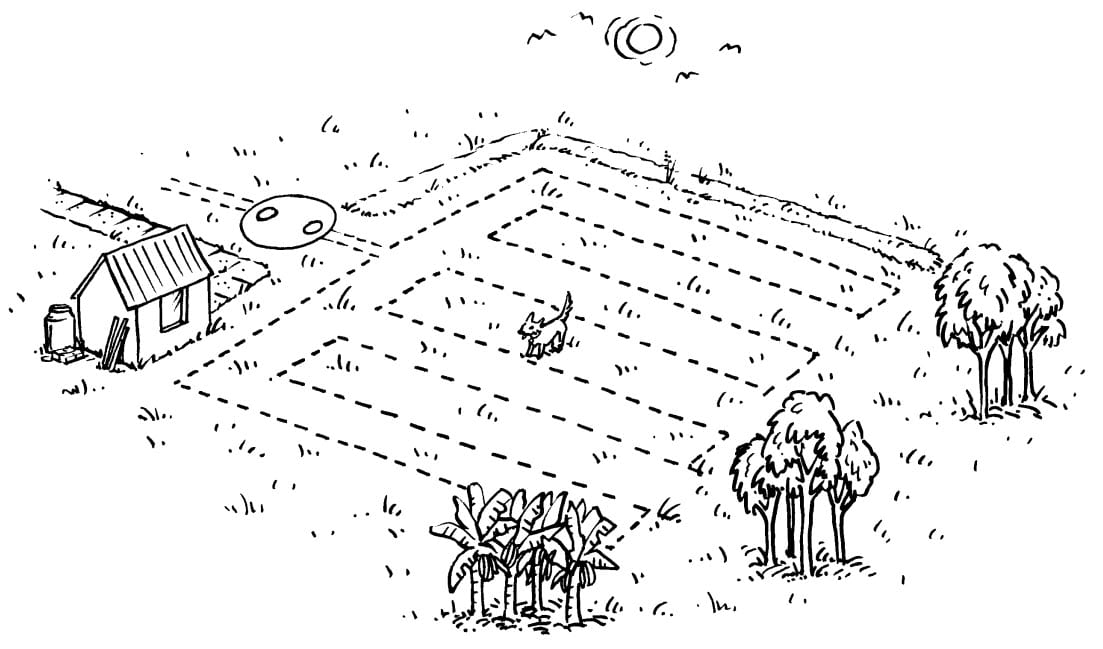
Recommended Reading: Guide to Wastewater Terms
The contents of a healthy septic tank should form 3 layers:
- A layer of fats (called scum) floats to the surface, helping to prevent odours from escaping and stopping air from entering
- A clear layer (called effluent), after treatment, flows out the outlet pipe as new wastewater enters.
- A layer of solids (called sludge or biosolids) sinks to the bottom and needs to be pumped out periodically.
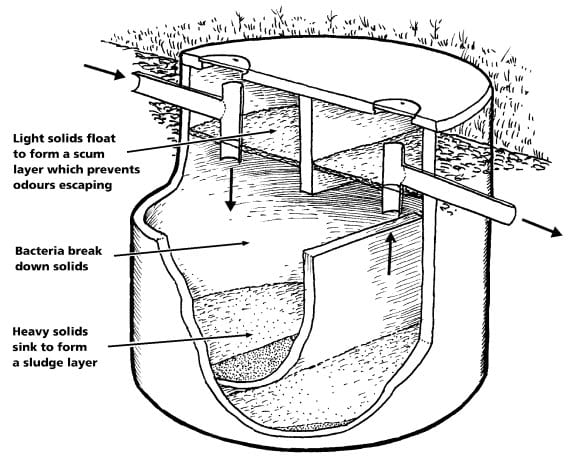
When choosing a septic system, the most important thing to consider is where it will be used, how it will be used and who will use it. For example, a septic system in a weekend holiday home will get far less use than a septic system in a large, permanently occupied family home.
The system chosen will largely depend on the suitability of your site for effluent absorption, how many people will live in the home, what area of land is available, what kind of lifestyle the family lives in, and what heavy water-use appliances are in the house.
You should factor in soil type, salt content, local rainfall, and the water table’s depth.
What Size Septic Tank Do I Need?
When installing a septic system for your home, one of the key considerations is choosing the right tank size. An appropriately sized septic tank helps your system operate efficiently and avoids issues like backups or expensive repairs. The required tank size depends on factors such as your home’s size, number of bedrooms, and expected daily wastewater output—generally, the more bedrooms, the larger the tank needed.
According to the International Association of Plumbing and Mechanical Officials (IAPMO), the following guidelines apply:
Number of Bedrooms | Minimum Tank Size
- 1–2 bedrooms | 3,000 litres
- 3 bedrooms | 4,000 litres
- 4 bedrooms | 5,000 litres
- 5 bedrooms | 6,000 litres
- 6 bedrooms | 7,000 litres
Recommended Reading:
With all that said, here are your typical options:
SAND FILTER SEPTIC SYSTEMS
After the wastewater is turned into effluent in your septic tank, it passes through a sand filter unit before being discharged into your absorption trench. A sand filter is usually a sealed unit about 9 meters long, often with turf growing on the top surface.
Sand filters capture suspended solids and provide an aerobic environment that encourages friendly bacteria that digest waste and reduce pollution.
EVAPOTRANSPIRATION BEDS
These systems are rare, used where soil conditions are less suitable for absorption trenches and where evaporation and transpiration rates normally exceed rainfall.
After the wastewater is turned into effluent in your septic tank, it passes through perforated pipes into a line gravel bed covered with turf. The water is removed by evaporation and transpiration through the grasses.
WETLAND TREATMENT SYSTEMS
Reed beds and wetland treatment systems tend to be used in larger industrial-sized sewage treatment plants and not often (if at all) in a domestic application.
Like the other methods, after the wastewater is turned into effluent in your septic tank, it flows out into a lined wetland where reed, aquatic flora, and fauna remove the nutrients before being dispersed into the absorption trenches or leach field.
ADVANCED SECONDARY TREATMENT SYSTEMS (STS) & AERATED WASTEWATER TREATMENT SYSTEMS (AWTS)
AWTS and Advanced Secondary Treatment Systems (STS) are fast becoming the most popular choice of septic systems used throughout New South Wales, ACT and Victoria. Garden Master septic systems are Advanced Secondary Treatment Systems and are the ones we often recommend.
Our Advanced STS systems can come in a two-tank or single large tank option. Per the other systems, wastewater is collected in a holding septic tank (or section within the single tank option) where solids settle, and anaerobic digestion occurs. The effluent is then moved on to the Aeration tank or section in the single tank option. In the second aeration tank/section, oxygen is bubbled through the effluent to encourage aerobic bacteria to digest the waste. Finally, the aerated effluent is disinfected using chlorine or ultra-violet light before being pumped to an irrigation area for disbursement.
Fixed-line drip irrigation systems are usually the preferred method of disbursement, although, in rural areas, some councils also permit the use of low-throw spray irrigation on larger properties. Aerated septic systems may also be used to treat greywater to a standard suitable for garden watering of non-food plants.
People using aerated septic systems must enter a regular maintenance contract for quarterly servicing, which the council may supervise.
Our Garden Master Elite Secondary Treatment System (STS) has been designed with a large capacity in mind. This will ensure safe and reliable operation even when doing multiple wash loads or when guests stay over. The last things you want are embarrassing odours emanating from your septic tank.
You will not have to live your life around your wastewater treatment plant. You can have peace of mind knowing that your Garden Master STS is operating quietly and efficiently.
Garden Master Elite – One tank, one hole and one connection, it couldn’t be easier:
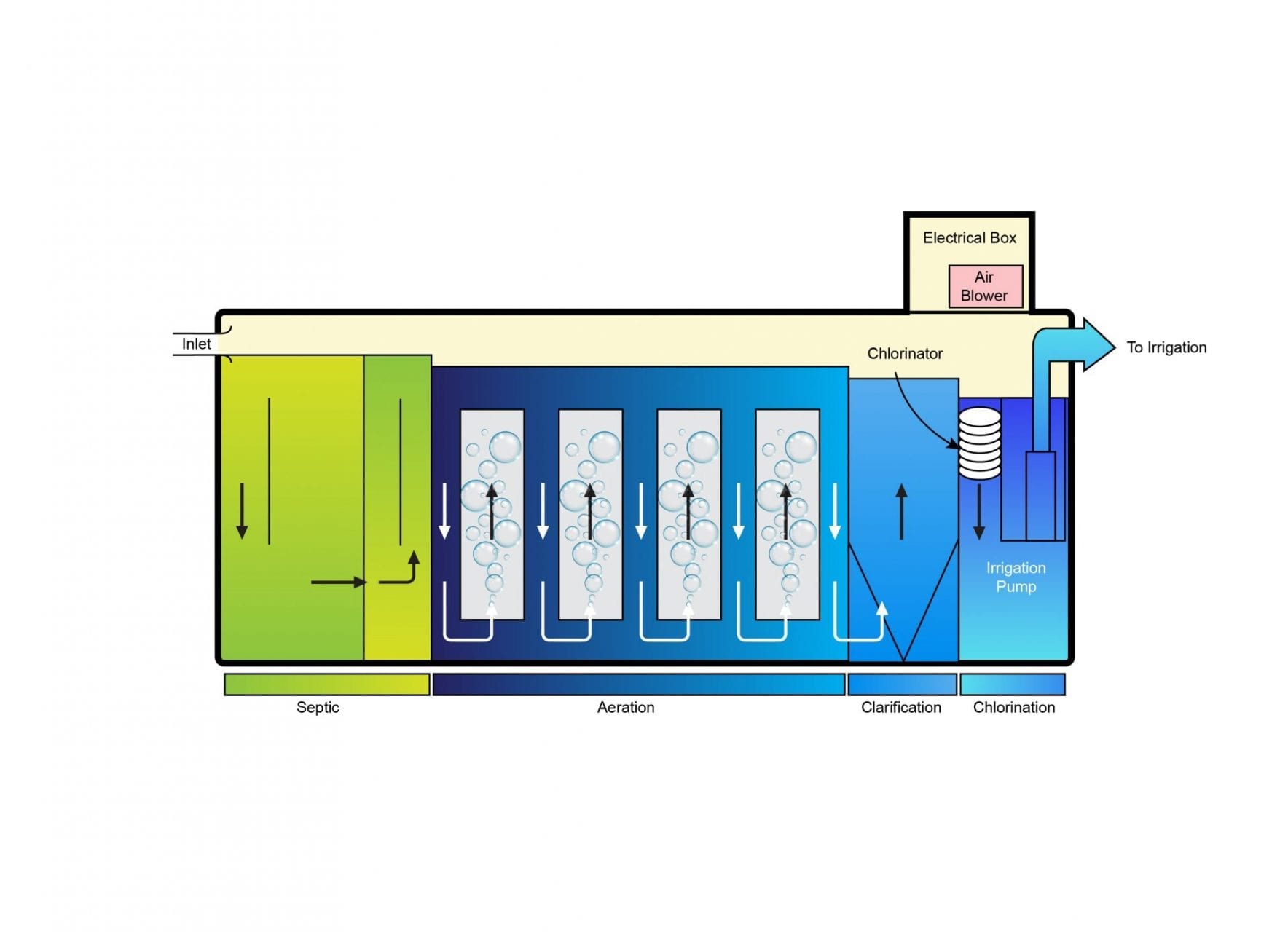
How much does a Septic System cost?
Septic tank and septic system prices vary depending on the type of system, the size of the home and the location. The average septic tank cost to buy for a four-bedroom home is between $10,000 and $20,000, with a one-off fee for installation plus yearly running costs with desludging every three to five years.
When getting quotes on your septic system, don’t forget to ask for a cost estimate for maintenance and installation. Some septic tank systems require very little maintenance beyond regular pumping. Others, like AWTS, need you to enter a standard maintenance contract for quarterly servicing, which the council may supervise.
What is the process of getting a quote through to installation?
Step 1. Consultation
Before buying a septic system, you must establish what design will suit your needs and site. A professional will need to check the soil to ensure that the area is suitable and has enough drainage. They will also check the site for the best locations for the drain field.
Step Two: System Design
Based on your site’s soil composition, location, house size and intended use, a system will be designed based on the best type of septic system for your property. This plan will include the best drain field placement and septic tank placement. While creating this plan, the engineer will meet all local standards and council requirements to ensure that the system complies with all proper standards and regulations.
Step Three: Approval
Once the design is complete, it must be approved. The local health department and authorities must inspect the plans and ensure they meet all necessary standards and regulations. They will ensure the layout has been created correctly and that drainage and wastewater treatment will not lead to groundwater contamination. Once the plan has been approved, the local health department will issue a permit to discharge, allowing the installation to begin.
Step Four: Installation
Once the system design has been approved, and the council issues an ‘approval to operate a system of sewage management’, which sets out the basic rules you need to follow to keep the system working well, your septic services company can install your system. A licensed installer will install your system.
Step Five: Operation and Use
After your system is installed, the installer will ensure everything is working correctly. Once the system is working correctly, your installer or another member of your septic services company will explain how your system works and provide you with essential instructions on caring for your new septic system. Before leaving you with your new system, your septic services company will ensure that you fully understand it and how to use it.
To help choose the best septic system for your needs, tailored to your site, it’s an excellent idea to speak with an industry professional.
Garden Master has been an industry leader for over 30 years, manufacturing, supplying and servicing quality wastewater treatment systems and septic tanks for thousands of clients across Australia.
Don’t hesitate to call us on 1800 632 582 with any questions or if you’re looking to buy septic tank!
Resources:
NSW Department of Local Government. 2000. The Easy Septic Guide. Developed by Social Change Media for the New South Wales Department of Local Government.
The Department of Planning and Environment – Water website also includes helpful information and resources about sewage management – https://www.industry.nsw.gov.au/water/water-utilities

